|
Books by
Jeffery Robenalt
|
|
In
the aftermath of the Great
Comanche Raid of 1840 and the Battle of Plum Creek, Mirabeau Lamar,
the President of the Republic of Texas, was convinced that
the depredations of the Penateka Comanches would continue unless the
savages were thoroughly chastised and taught that such hostile conduct
on their part would no longer be tolerated. The only way to administer
such a lesson was to carry the fight into the heart of the Comancheria.
To accomplish this difficult and dangerous mission, Lamar enlisted
the services of Texas Ranger Colonel John Moore, charging him with
the responsibility of organizing an expedition for the purpose of
attacking and destroying a Comanche winter village somewhere on the
upper reaches of the Colorado River or one of its many tributaries.
If an entire Penateka village could be set afoot and left without
the necessary foodstuffs to survive the winter, the action would clearly
demonstrate to the Comanches that there was no safe haven if they
failed to keep the peace.
Colonel Moore had led a similar expedition to Spring Creek
in the valley of the San
Saba River the previous February, but after an initial success,
the attack on the Comanche village ended in disaster when Moore ordered
an unexpected retreat. In his after action report, the Colonel stated
the retreat had been necessary because of poor visibility and the
need for his men to reload their weapons, however, not all the volunteers
agreed with this assessment.
The Lipan Chief Castro had gone so far as to withdraw his warriors
from the expedition and set out for home. To make matters worse, the
Comanches conducted a well-planned midnight raid and ran off with
more than half of Moore’s horses, forcing many of the men to return
to Austin on foot.
The Colonel was determined such a disaster would not occur again. |
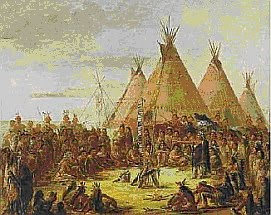 |
Tipis by George
Catlin
wikipedia |
The
first step in organizing the expedition was to recruit sufficient
manpower, and Moore set about doing this by posting circulars and
placing advertisements in local newspapers throughout the small towns
and widely scattered homesteads of frontier Texas. Considering all
the burning and killing the Comanches were responsible for on the
frontier, it was not surprising that the ads and circulars brought
a prompt response. By early October close to ninety volunteer Texas
Rangers, mostly from Fayette
and Bastrop counties gathered at Walnut Creek near the
new capital of Austin.
Having crossed over much of the same rugged hill country terrain on
his previous expedition, Colonel Moore made the decision to use pack
mules
to carry the expedition’s supplies instead of wagons. He also wanted
to keep from alerting the Comanches to the presence of the expedition
by hunting, so a small herd of cattle
would trail along behind the string of pack mules to serve as a mobile
commissary. |
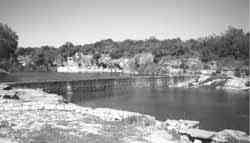 |
|
On Monday October
5, the expedition, led by Chief Castro and seventeen Lipan Apache
scouts, departed from the camp on Walnut Creek and headed north
toward the San
Gabriel River. Bearing west at the San
Gabriel, the column followed the river's course to its headwaters,
then moved cross country to the Colorado River, thus avoiding the
worst of the hill country. After fording the Colorado, the volunteers
continued northwest, crossing both the San
Saba and Llano
rivers.
|
| Throughout the
expedition’s route, the Lipan scouts spread out, thoroughly scouring
the countryside for any sign of the Comanches, but none was found.
Undaunted, the Rangers pushed further to the northwest. Moore was
one of the first white men to travel so deep into the western reaches
of the Colorado River, and in his later report he stated that
he “found the country rich and beautiful, abundant in game, and
covered with a waving sea of grass broken only by occasional rivers
and canyons, with tremendous vistas.” |
Concho River
Watershed
wikipedia |
As the expedition
drew closer to the Concho River a “blue norther” storm unexpectedly
rolled in and the weather took a severe turn for the worse. Torrential
freezing rain and near gale-force, icy winds plagued the trail, and
it was impossible for the Rangers to stay dry in the miserable conditions.
A number of men became ill as the column continued to plod on through
miles of deep clinging mud and standing water.
One young Ranger, Garrett Harrell, drowned while the expedition was
fording the raging flood waters of the Concho, and Colonel
Moore was beginning to grow discouraged after so many days on the
trail with no sign of the Comanches and little letup in the gloomy
weather. He reluctantly ordered the column to follow the Concho
back to its confluence with the Colorado where he planned to
return to Austin if nothing
turned up and the weather conditions failed to improve. |
Colorado River
Watershed
wikipedia |
However, the
rain abated somewhat as the Rangers drew nearer to the Colorado.
More importantly, the Lipan scouts found tracks of a large number
of unshod horses mixed in with the drag marks of many travois and
the footprints of women and children; clear signs of a village on
the move. The Rangers followed the tracks northwest along the Colorado,
and on October 23, they came across a large grove of pecan trees where
the Comanches had stopped to gather nuts for the winter.
Most of the pecans had been harvested, and with such a heavy load
to carry, the scouts were sure the encampment was not far off. After
ordering the men to take cover in a brushy thicket on the reverse
side of a hill sheltered from the icy blast of the north wind, Colonel
Moore called on his two best scouts to ride ahead. Departing at mid-morning,
the Lipans did not return until near sundown, but they brought welcome
news. The Comanche village was located on a horseshoe bend of the
Colorado less than twenty miles distant. |
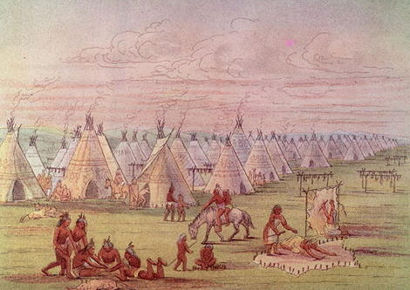 |
Comanche Village
by George Catlin, 1834
Courtesy of www.georgecatlin.org |
The news of the
discovery energized the Rangers, and in spite of the miserable weather,
they were eager for an engagement. After eating a cold supper, Colonel
Moore led the column ten miles up the Colorado where the men
secured their small herd of cattle in a mesquite thicket near the
river and continued on for a few more miles.
Halting the march at midnight, Moore ordered the Rangers to dismount
and rest their horses while he dispatched the same two Lipan scouts
to determine the exact location of the village and gather an estimate
of the Comanches’ strength. The Lipans returned a few hours before
sunrise and reported a village four miles upriver on the south bank
of the Colorado with sixty to seventy lodges and an estimated
125 warriors. The column continued its advance for another two miles
where they secured their pack animals in a wooded hollow and waited
for daylight.
Near sunrise on October 24, Colonel Moore gave the long-awaited order
to mount and move forward. As the Rangers approached the sleeping
village, Lieutenant Clarke Owen, recently arrived at Austin
from Mississippi, was ordered to ford the Colorado below the
camp with the Lipan scouts and be prepared to deal with any Comanches
who managed to make it across the river. Captain Thomas Rabb from
La Grange and his men
would form up on the right, Captain Nicholas Dawson from Bastrop
and his men would be on the left, and Colonel Moore would ride with
the men of Lieutenant Owens and command from the center.
The Rangers moved to within two hundred yards of the encampment without
being detected and slowly went on line; only the fog-muted jingle
of harness and the soft squeaking of saddle leather disturbed the
deathly silence of the early morning. When all was in readiness Colonel
Moore gave the signal and the entire command started forward at a
walk, quickly moved into a trot, and finally broke into a thundering
gallop. |
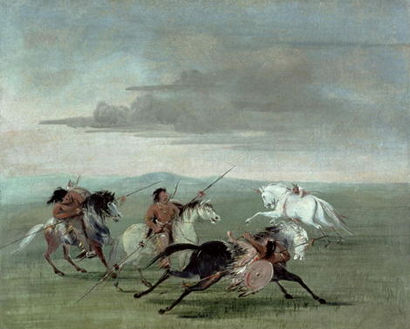 |
Comanche Warriors
by George Catlin
Courtesy of www.georgecatlin.org |
The Comanches
were taken by complete surprise, stumbling out of the snug warmth
of their buffalo robes only to be greeted by the howling screams of
the Rangers and the hammer-like pounding of countless hooves. Nearly
naked and weaponless, the Indians fled for the perceived safety of
the ford on the Colorado.
The rangers brought down a virtual hail of gunfire on the retreating
and confused Indians as they galloped into the village unchallenged.
Halfway through the scattered buffalo-hide lodges Moore called for
the men to rein in so they could dismount and reload. After quickly
reloading, the Rangers continued to fire until the barrels of their
long rifles were smoking hot. Many Comanches were killed before they
reached the Colorado, and a large number of others were brutally
gunned down as they attempted to flounder across the ford, their bodies
swirling away with the current.
The Rangers advanced to the river in an orderly fashion and continued
to fire at the fleeing Comanches, hitting many of them as they emerged
from the river on the opposite bank. The Comanches who were fortunate
enough to run the deadly gauntlet of fire from the village and safely
reach the far bank fled across the open prairie only to be ridden
down by Lieutenant Owens and his Lipans who had been eagerly awaiting
just such an opportunity.
The scene was one of carnage. Bodies of dead, dying, and wounded Comanche
men, women, and children lay sprawled across the village and both
banks of the Colorado. Although an honest effort had been made
by most of the Rangers to spare the lives of the women and children,
a good number of them had been killed or wounded in the confusion
of the fight.
Colonel Moore later reported that forty-eight Comanches had been “killed
upon the ground, and eighty killed and drowned in the river.”
Many of the Rangers believed this estimate was too low. Thirty-four
Comanche prisoners were taken during the fight. None of the Rangers
were killed and only two suffered minor wounds. |
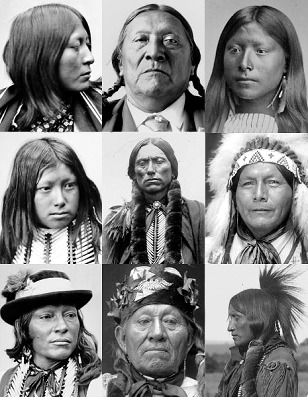 |
Comanche
Portraits
wikipedia |
|
The
victory on the Colorado was undoubtedly the most severe punishment
the Comanches had ever received at the hands of the Texas Rangers.
In addition to the many casualties and prisoners the Indians suffered,
all the property and food in the village was either confiscated
or destroyed, including much of the loot that had been carried away
from the raid on Victoria
and Linnville.
More than five hundred Comanche horses were also rounded up.
The Rangers returned to Austin
on November 7, with the welcome news of their victory, and the grateful
citizens held a dinner and celebration in their honor. The power
of the southern Penateka Comanches was forever broken, and although
they remained a nuisance, they were never able to fully recover
from the results of the devastating defeat on the Colorado
coupled with the losses they had suffered at the Council
House fight and Plum
Creek. However, the Texans and the northern Comanche tribes
had not yet come into meaningful contact, and the struggle for control
of the western frontier would continue for many more years.
© Jeffery
Robenalt
"'A Glimpse of Texas Past"'
January
25, 2011 Column
|
|
|
